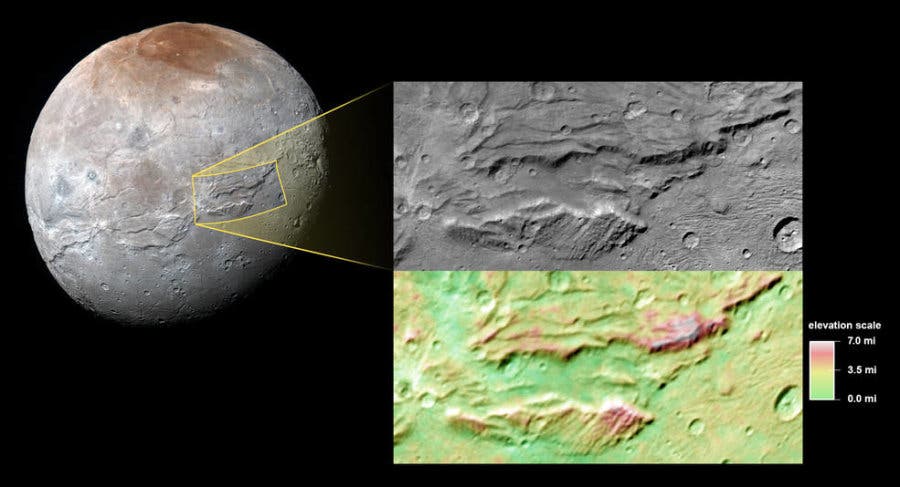As NASA’s New Horizons shuttle zoomed past Pluto, it snapped awesome photos not only of the “ex-planet”, but also of its moons. Now researchers are analyzing those pictures and reporting surprising finds – such as an ancient ocean on Charon, Pluto’s moon.
Too big for its skin?

Pluto’s Moon Charon A close-up of the canyons on Charon, Pluto’s big moon, taken by New Horizons during its close approach to the Pluto system last July. Multiple views taken by New Horizons as it passed by Charon allow stereo measurements of topography, shown in the color-coded version of the image. The scale bar indicates relative elevation.
Credit: NASA/JHUAPL/SwRI
The side of Pluto’s largest moon viewed by NASA’s passing New Horizons exhibits feature of “pull apart” tectonic faults. Faults are basically discontinuities in large volumes of rock, with significant displacements. The mass of rock can move towards each other, away from each other or slide by each other in a parallel line. Pull apart faults are areas where rocks move away from each other, and they are usually expressed by ridges, scarps and valleys – all of which can be observed on Charon. Some valleys are actually 4 miles (6.5 kilometers) deep, which is extremely impressive when you consider that its entire mean radius is 606 kilometers.
However, Charon can’t have tectonics like Earth has, because it doesn’t have a hot core and mantle that circulates under the crust, so researchers propose a different mechanism. Charon’s outside is primarily water ice. It’s all frozen, but this might have not always been always the case. When Charon was young, this layer was probably kept warmer by heat provided by the decay of radioactive elements, as well as Charon’s own internal heat of formation. It was probably hot enough to melt some of the water, so Charon had a subsurface ocean. But as Charon cooled over time, this ocean would have frozen. When water freezes, it expands, lifting the outer layers and pulling them apart.
This process makes a lot of geological sense, but the entire process must have been extremely violent. Charon exhibits one of the longest systems of chasms in the solar system, running at least 1,100 miles (about 1,800 kilometers) long and reaching 4.5 miles (7.5 kilometers) deep. By comparison, the Grand Canyon is 277 miles (446 kilometers) long and just over a mile (1.6 kilometers) deep.









